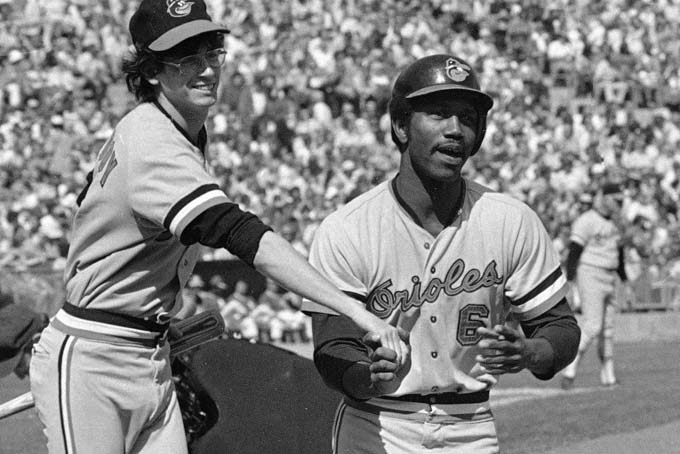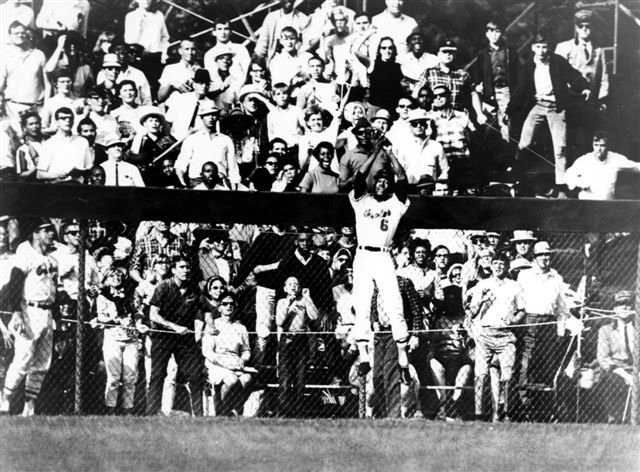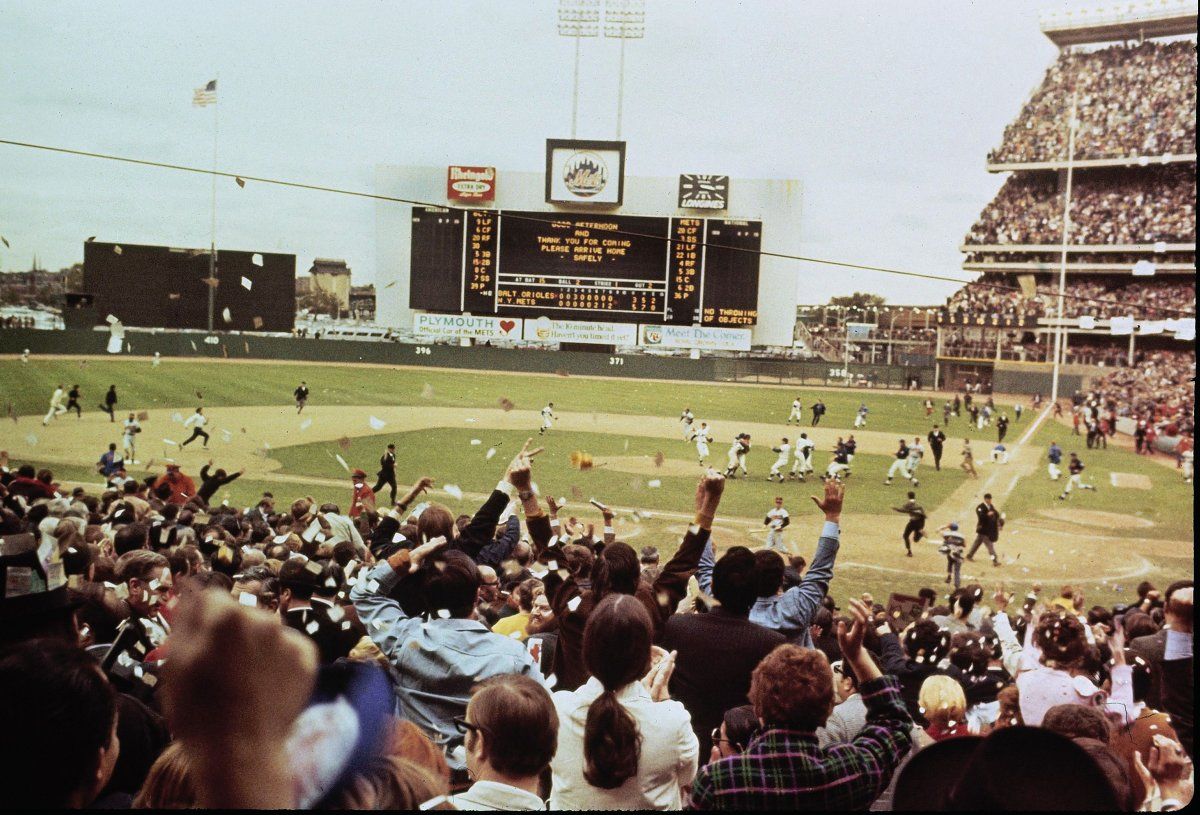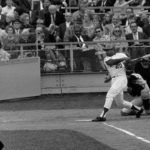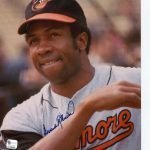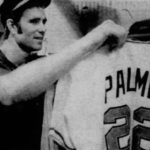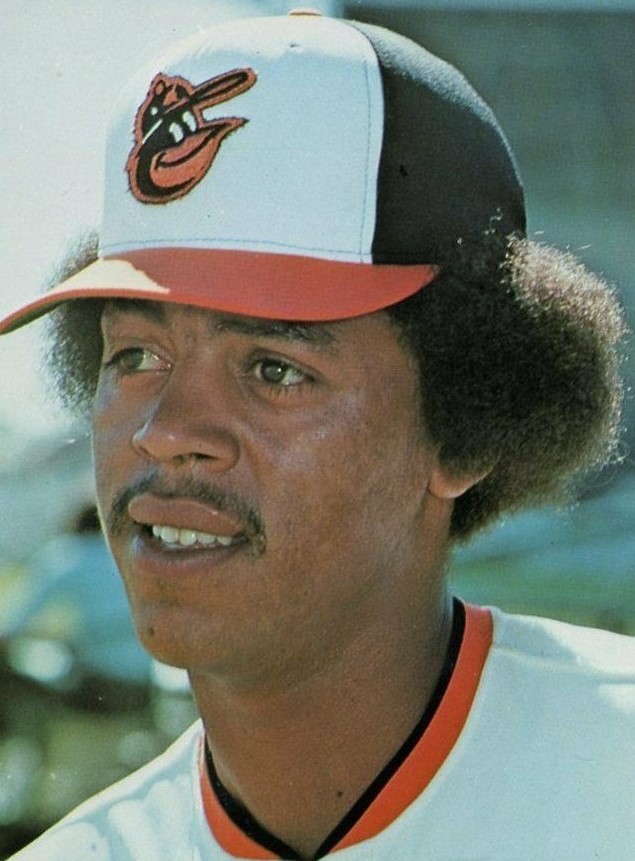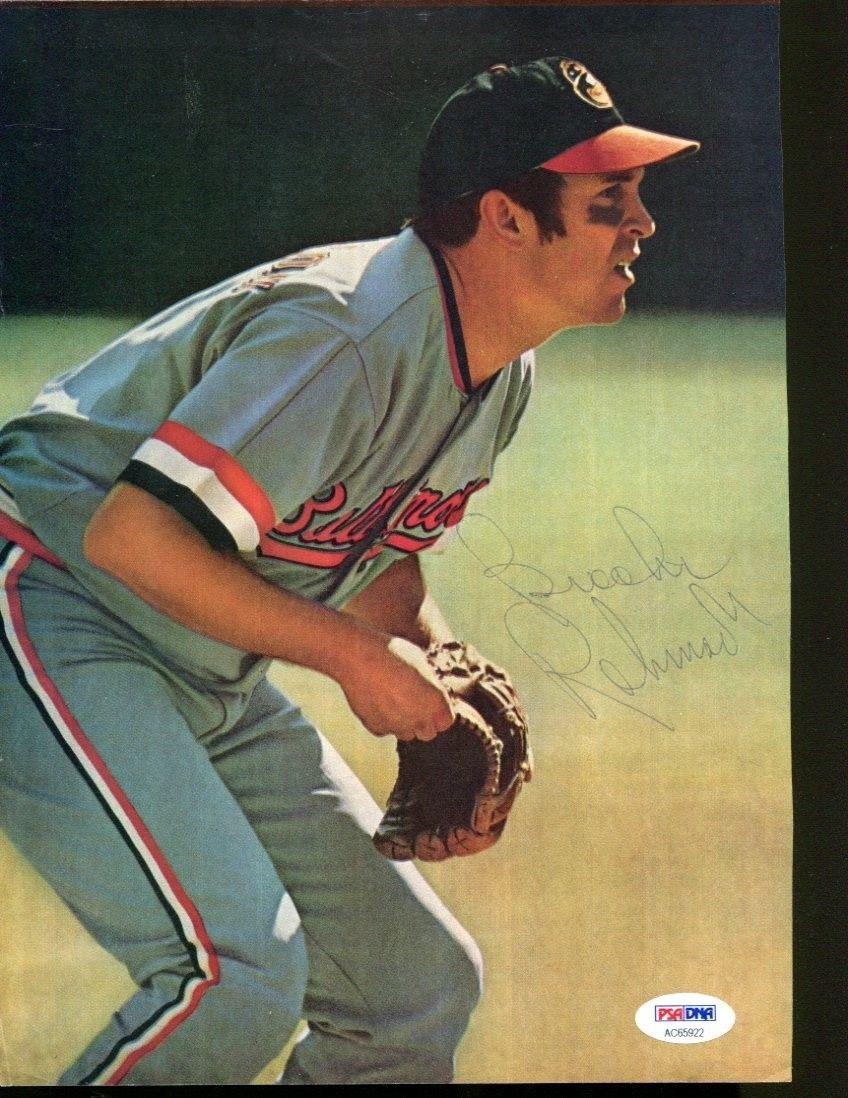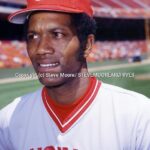Paul Blair Stats & Facts
Paul Blair
Position: Centerfielder
Bats: Right • Throws: Right
6-0, 168lb (183cm, 76kg)
Born: February 1, 1944 in Cushing, OK
Died: December 26, 2013 (Aged 69-328d) in Baltimore, MD
Buried: Cremated
High School: Manual Arts HS (Los Angeles, CA)
Debut: September 9, 1964 (Age 20-221d, 9,898th in MLB history)
vs. WSA 0 AB, 0 H, 0 HR, 0 RBI, 0 SB
Last Game: June 20, 1980 (Age 36-140d)
vs. OAK 0 AB, 0 H, 0 HR, 0 RBI, 0 SB
Nicknames: Motormouth
Paul Blair Baseball Reference Page
View Player Bio from the SABR BioProject
Nine Other Players Who Debuted in 1964
Tony Perez
Bert Campaneris
Don Kessinger
Paul Blair
Lou Piniella
Phil Niekro
Luis Tiant
Mel Stottlemyre
Mickey Stanley
The Paul Blair Teammate Team
C: Thurman Munson
1B: Boog Powell
2B: Joe Morgan
3B: Brooks Robinson
SS: Luis Aparicio
LF: Don Buford
CF: Mickey Rivers
RF: Frank Robinson
DH: Reggie Jackson
SP: Jim Palmer
SP: Mike Cuellar
SP: Dave McNally
SP: Ron Guidry
SP: Tom Seaver
RP: Stu Miller
RP: Goose Gossage
M: Earl Weaver
Notable Events and Chronology for Paul Blair Career
Intro
An eight-time Gold Glove Award winner, Paul Blair was the best defensive center fielder in the American League in the late 1960s and early 1970s. With uncanny instincts and great speed, Blair positioned himself perfectly, often gliding in to shallow center to snare would-be singles. He had several great moments in the post-season, including a game-winning homer in Game Three of the 1966 World Series, and a leaping catch the next day to prevent a home run. He recovered from a beaning in 1970 to play another decade, and he earned four World Series rings, two with the Orioles and two with the Yankees.
PAUL BLAIR BIOGRAPHY
Paul Blair JR. was originally signed by the New York Mets as an amateur free agent in 1961. After spending the 1962 season in their farm system, he was drafted by the Orioles in the 1962 first-year draft. He broke into the Orioles’ lineup in 1965 and, despite batting average only .234 with five home runs and 25 run batted in, impressed many with his defensive skills.
In 1966 he batted .277 and won his first of four World Series titles. In Games Three and Four of that 1966 World Series, which the Frank Robinson-led Orioles swept from the defending champion Los Angeles Dodgers in four games, Blair played a major role in 1-0 shutouts by Wally Bunker and Dave McNally respectively, hitting a 430-foot home run off Claude Osteen in Game Three, and robbing Jim Lefebvre of an eighth-inning home run that would have tied Game Four.
In 1967 Blair established a career high .293 batting average with 11 home runs and 64 RBIs, along with an American League-leading 12 triples. He also won the first of his eight Gold Glove Awards.
After slumping to .211 in 1968, Blair had perhaps his best season in 1969. Batting second behind Don Buford in the Orioles’ lineup, he hit .285 with career highs in home runs (26), runs batted in (76) and runs (102). He also made the All-Star team for the first time; he would repeat this feat in 1973. His Orioles won the pennant, but lost to the New York Mets in the 1969 World Series. Blair went only 2-for-20 in that Series, including being the victim of one of Tommie Agee’s two spectacular Game Three catches (Agee had also robbed Elrod Hendricks earlier in the game). On an interesting sidenote, on that Agee catch, Blair would be the first batter Nolan Ryan would face in a World Series—the only World Series game the Baseball Hall of Fame pitcher would participate in. One of Blair’s two hits came in the seventh inning of Game Two; it broke up Jerry Koosman’s bid for a no-hitter.
On May 31, 1970 Blair was beanball by Los Angeles Angels of Anaheim pitcher Ken Tatum and suffered a broken nose. He recovered quickly, finishing the season batting .267. That year, Baltimore won another pennant and defeated the Cincinnati Reds in five games in 1970 World Series. Both Blair and Series MVP Brooks Robinson atoned for their 1969 World Series performances (Robinson went 1-for-19, the lone hit coming in Game Two, scoring Blair; he was himself the victim of a spectacular catch, by Ron Swoboda in Game Four) by tying a five-game Fall Classic record with nine hits apiece.
In 1971 Blair took up switch hitter but stopped after batting only .193 (11-for-57). He finished the season hitting .262. His Orioles won another pennant, but lost the 1971 World Series to the Pittsburgh Pirates in seven games.
Blair’s speed going back in the outfield enabled him to play shallow, and make catches à la Willie Mays. In each of the Orioles’ three consecutive World Series seasons, Blair won a Gold Glove. He would also win a Gold Glove over the next four seasons, his last Gold Glove in 1975 coinciding with teammate Brooks Robinson winning his 16th consecutive—and last—Gold Glove at third base.
On January 20, 1977, Blair was traded to the New York Yankees for outfielders Elliott Maddox and Rick Bladt. On June 18 of that year in a nationally televised game against the Boston Red Sox at Fenway Park, he was involved—though not directly—in one of the most bizarre scenes in baseball history. Yankee manager Billy Martin took right fielder Reggie Jackson out of the game and replaced him with Blair after Jackson had misplayed Jim Rice’s fly ball for a double. As the cameras watched, Jackson and Martin nearly came to blows. After winning World Series titles with the Yankees in 1977 and 1978, Blair was released early in the 1979 season.
The Cincinnati Reds signed him as a free agent less than a month later, and Blair returned to the Yankees in May of 1980. He retired after the Yankees released him a second time, on July 1 of that year.
In his 17-year career, Blair, whose nickname, “Motormouth,” came from his talkative nature, batted .250 with 134 home runs and 620 RBIs, 1513 hits and 171 stolen bases in 1947 games played. He was also one of the top Bunt (baseball) in the game, recording at least 10 sacrifice hits four times in his career, including 17 during the 1975 season.
Personal life Blair currently resides in Owings Mills, Maryland and works out at Triangle Fitness in Eldersburg, Maryland. He also bowls at Kings Point Lanes in Reisterstown, Maryland. His son Paul Blair III played eight years in the minors for the San Francisco Giants and the Chicago Cubs.
Quotes About
“I never saw Paul Blair’s first step.” — Earl Weaver, on Blair’s amazing range in center field.
Quotes From
“Earl [Weaver] and Billy [Martin] were a lot alike. Both were fiery and competitive. But there was one big difference: Earl was forgiving. Billy held a drudge. Once you got into Billy’s doghouse, you were there to stay.”
Best Season
Blair set career-highs in at-bats, hits, runs, doubles, homers, and RBI. He hit .400 on the AL Playoffs, but struggled in the World Series, going 2-for-20.
Factoid 1
Center fielder Paul Blair was the first outfielder to ever win a Gold Glove for the Baltimore Orioles and was the only Centerfielder until Adam Jones won the award.
Factoids, Quotes, Milestones and Odd Facts
Played For
Baltimore Orioles (1964-1976)
New York Yankees (1977-1979)
Cincinnati Reds (1979)
New York Yankees (1980)
Blair coached the baseball team for Coppin State (Baltimore, Maryland) for five seasons. Despite leading the program to improvement, he was let go.
Similar: Defensively, Jimmy Piersall.
Linked: Blair and Reggie Jackson were teammates with Baltimore in 1976, and in the Bronx with the Yankees in 1977-1978. Blair, who was a calming influence in the clubhouse, claimed that had he not been in New York, Reggie would have been in a fight every day of the 1977 season.
Best Season, 1969
Blair set career-highs in at-bats, hits, runs, doubles, homers, and RBI. He hit .400 on the AL Playoffs, but struggled in the World Series, going 2-for-20.
Awards and Honors
1967 AL Gold Glove
1969 AL Gold Glove
1970 AL Gold Glove
1971 AL Gold Glove
1972 AL Gold Glove
1973 AL Gold Glove
1974 AL Gold Glove
1975 AL Gold Glove
Post-Season Appearances
1966 World Series
1969 American League Championship Series
1969 World Series
1970 American League Championship Series
1970 World Series
1971 American League Championship Series
1971 World Series
1973 American League Championship Series
1974 American League Championship Series
1977 American League Championship Series
1977 World Series
1978 American League Championship Series
1978 World Series
Description
As a teenager out of Los Angeles, Blair was a skinny six-footer. He added muscle as he matured in the minors. He was lean and fast, and had quick wrists. He was known as a great fastball hitter, who liked the ball inside. He crowded the plate, which is one reason he was hit by Tatum’s pitch in 1970.
Factoid
Center fielder Paul Blair is the only outfielder to ever win a Gold Glove for the Baltimore Orioles.
Where He Played: Blair had always been a shortstop, until he got into the minor leagues. The Orioles made him an outfielder, and he quickly became the top non-pitching prospect in their organization. The Dodgers refused to sign Blair out of high school, he because they thought he was too small to make it the big leagues. He was signed by the Mets originally, for a $2,000 bonus.
Big League Debut: September 9, 1964
Blair was a pinch-runner in his first game, and did not play in the field or come to bat. He appeared in eight games that season, but only came to bat in the final game, when he struck out against Ed Rakow.
Post-Season Notes
Blair hit the longest home run of his career in Game Three of the 1966 World Series. It was a 430-foot blast to center field off Claude Osteen in Memorial Park in Baltimore.
Feats: Blair set a World Series record with nine hits in the five-game 1970 World Series.
Injuries and Explanation for Missed Playing Time
In 1970, Blair was hit in the cheek, under his left eye, by a fastball from Ken Tatum of the Angels. It shattered about four different bones in his face and he underwent surgery. He missed 21 games, but rebounded to play another 10 seasons. Contrary to some who say he was never quite the same hitter, Blair claimed he was unaffected by the incident. He never saw Tatum’s pitch, so, Blair said “I was never haunted by images of the ball hitting me.”
Hitting Streaks
17 games (1969)
Transactions
After the 1976 season, Blair wanted out of Baltimore. The shoddy way in which Brooks Robinson had been treated, and other moves, had soured him on the Oriole front office. He requested a trade, and was dealt to the Yanks for Elliott Maddox and Rick Bladt.
Quotes About Blair
“I never saw Paul Blair’s first step.” — Earl Weaver, on Blair’s amazing range in center field.
Quotes From Blair
“Earl [Weaver] and Billy [Martin] were a lot alike. Both were fiery and competitive. But there was one big difference: Earl was forgiving. Billy held a drudge. Once you got into Billy’s doghouse, you were there to stay.”
Matchup Data
Blair had great success against Jim Kaat. He batted .345 (38-for-110) with five homers against the lefty. The right-handed hitting Blair batted .261/.416/.302 off lefties, and .244/.360/.303 against RHP in his career.
All-Star Selections
1969 AL
1973 AL
Replaced
Jackie Brandt, a former Gold Glove Award winner, who was at the tail end of his career.
Replaced By
Al Bumbry, another product of the rich Baltimore farm system, who had caddied for Blair for a few years, and also filled in at left field when needed. Bumbry had won the 1973 Al Rookie of the Year Award, but still had a hard time cracking the deep Baltimore starting lineup. He was quick like Blair, could bunt well, and had fine range in center, but he lacked the instincts that Blair had in the outfield.
Best Strength as a Player
His positioning in center, his range, and his speed and bunting skills.
Largest Weakness as a Player
Ability to handle the outside pitch. Blair, by his own admission, was too stubborn to hit the outside pitch the other way. He was a pull-hitter who loved the inside fastball. When he popped 26 homers in 1969, he abandoned any notion of spraying the ball around to increase his average.
Sources used for the Paul Blair Player Page:
Interview with Paul Blair, March 4, 2006
Paul Blair Legends Series event, National Baseball Hall of Fame and Museum, hosted by Jeff Arnett, Director of Museum Prgramming and Education, March 4, 2006
Other Resources & Links
Coming Soon
If you would like to add a link or add information for player pages, please contact us here.

